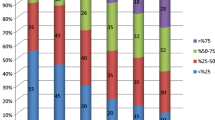Abstract
Background
Vagus nerve stimulation (VNS) is approved for use in patients with refractory epilepsy over the age of 12 years. While this procedure is widely used, there is little data on adverse events in young children.
Materials and methods
A retrospective chart review was conducted on 26 children who had VNS implantation for refractory epilepsy from 1998 to 2004.
Results
Ages ranged from 3 to 17 years (16 boys and 10 girls). Seventy-seven percent had moderate to severe mental retardation. Sixty-five percent had more than 30 seizures per month. Symptomatic-generalized epilepsy was the predominant epilepsy syndrome seen in 77% of children. The duration of VNS treatment ranged from 1 month to 8 years (mean = 3.5 years). Twenty of 26 patients (77%) were on rapid-cycling mode. More than 50% reduction in seizure frequency was noted in 54% with two patients achieving seizure freedom. Twenty-three percent had less than 50% seizure reduction. Four patients were able to terminate seizures with use of the magnet. VNS was removed from one patient because of intractable cough persisting in spite of stimulation being turned off for 1 month. Another patient had it removed twice for infection. Obstructive sleep apnea (OSA) was observed in four patients (15%) after placement of VNS.
Conclusion
VNS appears to be an effective treatment for children with refractory epilepsy. Development of intractable cough in one patient in spite of device being turned off and recurrent infection-related removal in another are unusual complications. Polysomnography before implantation of VNS should be considered to identify patients with pre-existing OSA.
Similar content being viewed by others

References
Ben-Menachem E et al (1999) Evaluation of refractory epilepsy treated with vagus nerve stimulation for up to 5 years. Neurology 52(6):1265–1267
Guillemault C, Lee JH, Chan A (2005) Pediatric Obstructive sleep apnea syndrome. Arch Pediatr Adolesc Med 159:775–785
Helmers SL, Wheless JW, Frost M, Gates J, Levisohn P, Tardo C, Conry JA, Yalnizpglu D, Madsen JR (2001) Vagus nerve stimulation in pediatric patients with refractory epilepsy: retrospective study. J Child Neurol 16:843–848
Holmes MD, Chang M, Kapur V (2003) Sleep apnea and excessive daytime somnolence induced by vagal nerve stimulation. Neurology 61:1126–1129
Koh S, Ward SL, Lin M, Chen LS (2000) Sleep apnea treatment improves seizure control in children with neurodevelopmental disorders. Pediatr Neurol 22:36–39
Majoie HJ et al (2005) Vagus nerve stimulation in patients with catastrophic childhood epilepsy, a 2 year follow-up study. Seizure 14:10–18
Malow BA, Edwards JA, Marzec M, Sagher O, Fromes G (2000) Effects of vagus nerve stimulation on respiration during sleep: a pilot study. Neurology 55:1450–1454
Malow BA, Fromes GA, Aldrich MS (1997) Usefulness of polysomnography in epilepsy patients. Neurology 48:1389–1394
Marzec M, Edwards J, Sagher O, Fromes G, Malow BA (2003) Effects of vagus nerve stimulation on sleep related breathing in epilepsy patients. Epilepsia 44:930–935
Mcgregor A, Wheless J, Baumgartner J, Bettis D (2005) Right-sided vagus nerve stimulation, a treatment for refractory epilepsy in humans. Epilepsia 46:91–96
Nagarajan L, Walsh P, Gregory P, Lee M (2002) VNS therapy in clinical practice in children with refractory epilepsy. Acta Neurol Scand 105(1):12–17
Nagarajan L, Walsh P, Gregory P, Strick S, Maul J, Ghosh S (2003) Respiratory pattern changes in sleep in children on vagal nerve stimulation for refractory epilepsy. Can J Neurol Sci 30:224–227
Rudolph RL. Food and Drug Administration neurological devices panel web site. Available at http://www.fda.gov/ohrms/dockets/ac/04/briefing407b1 01 Clinical Executive Summary-FINAL pdf
Valencia I, Holder DL, Helmers SL, Madsen JR, Riviello JJ (2001) Vagus nerve stimulation in pediatric epilepsy: a review. Pediatr Neurol 25:368–376
Vaughn BV, D’Cruz OF, Beach R, Messenheimer JA (1996) Improvement of epileptic seizure control with treatment of obstructive sleep apnea. Seizure 5:73–78
VNS Stimulation Study Group (1995) Neurology 45:224–230
Cyberonics (2003) VNS physicians manual. Cyberonics, Houston, TX
Zamponi N et al (2002) Intermittent vagal nerve stimulation in pediatric patients. 1 year follow up. Child’s Nerv Syst 18(1):61–66
Author information
Authors and Affiliations
Corresponding author
Additional information
S. Neff, deceased during publication of this article.
Rights and permissions
About this article
Cite this article
Khurana, D.S., Reumann, M., Hobdell, E.F. et al. Vagus nerve stimulation in children with refractory epilepsy: unusual complications and relationship to sleep-disordered breathing. Childs Nerv Syst 23, 1309–1312 (2007). https://doi.org/10.1007/s00381-007-0404-8
Received:
Revised:
Published:
Issue Date:
DOI: https://doi.org/10.1007/s00381-007-0404-8



